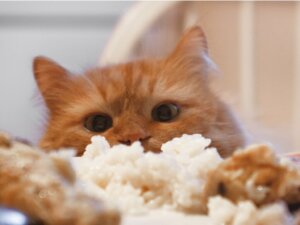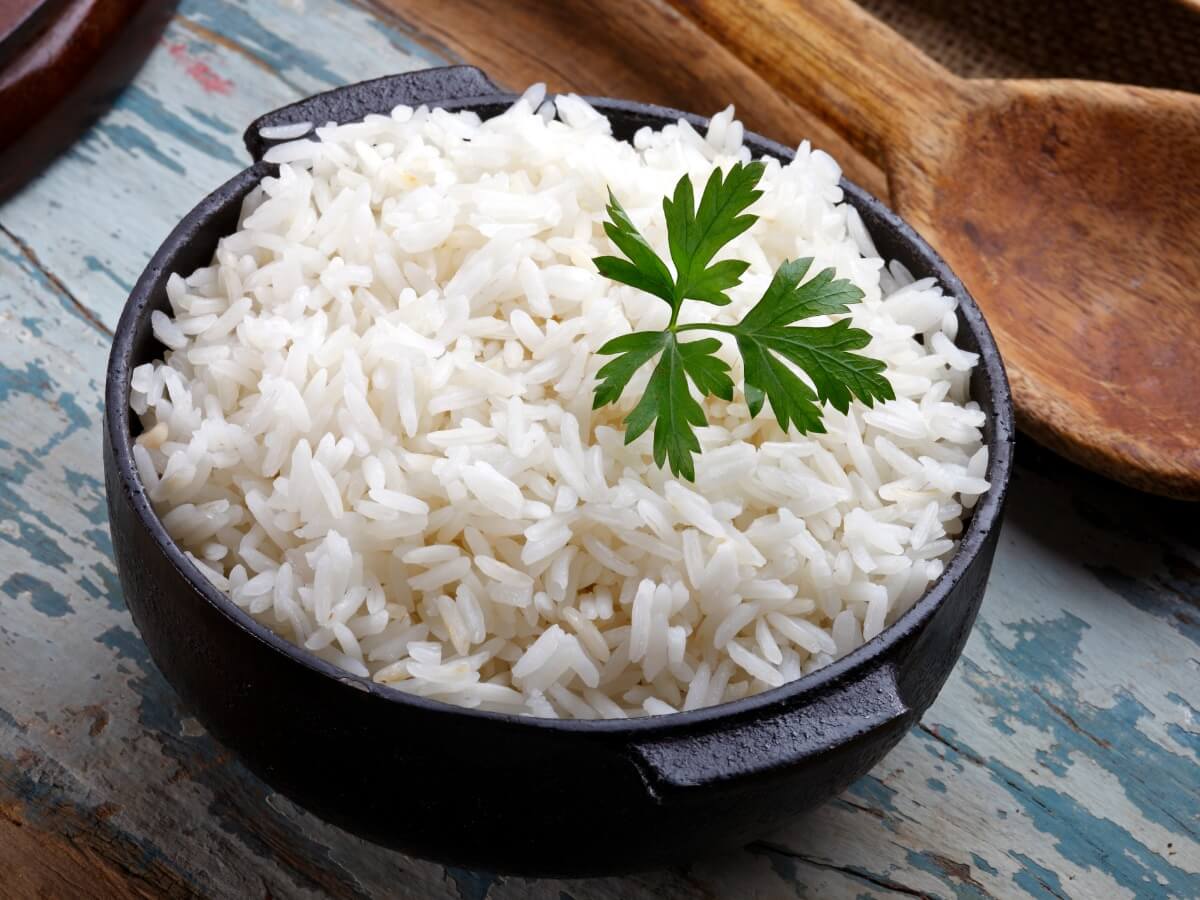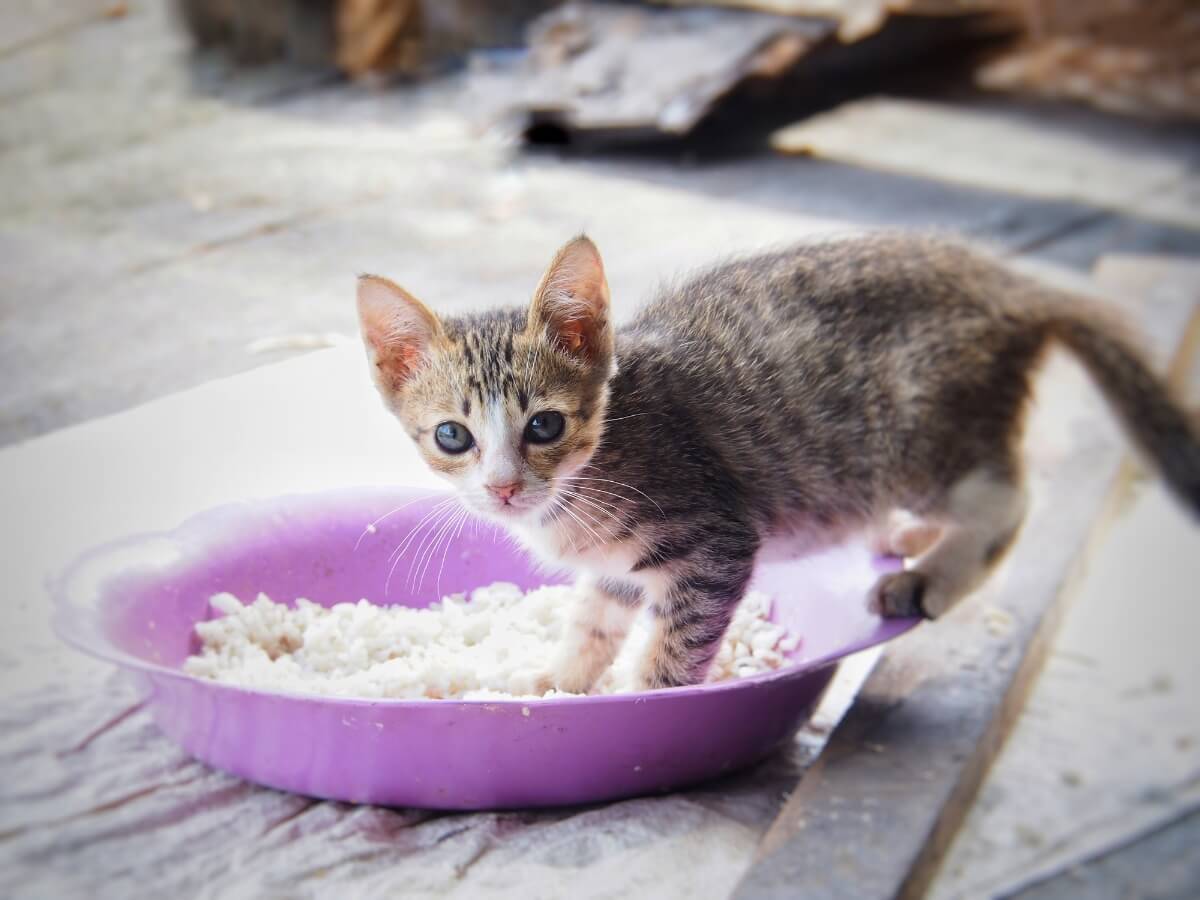Can Cats Eat Rice?

Rice has been part of the human diet for thousands of years and is one of the staples of many households around the world. In addition, it’s easy to handle, is cheap, and has high nutritional properties. However, this doesn’t mean that it works in the same way in animals. Therefore, the following question arises: can cats eat rice?
Many have wondered if rice is a good option to give to cats when their usual food has run out and you’re not able to go out to buy any at that time. Let’s have a look at the properties of rice and the effects that this grain can produce when it’s included in your cat’s diet.
Properties of rice
Rice is a seed that comes from the Oryza sativa plant, which, in turn, belongs to the Poaceae or grass family, from which most of the human diet comes. This grain is one of the most produced cereals in the world and is the source of a fifth of the calories consumed by man.
In the same way, it’s a great source of energy, because it’s composed of starches. In addition, it contains B vitamins and is rich in fiber. Added to this, it’s a low-fat food, but with high iron content and high levels of water. 100 grams (4 oz) of cooked white rice provide 130 kilocalories.
100 grams (4 oz) of rice contains 28 grams (1 oz) of carbohydrates. Carbohydrates are its main component.

Can cats eat rice?
So can you give your feline rice? The answer is yes, as rice isn’t a toxic food for cats. However, there are always exceptions in pets, and so it’s important to ask a veterinarian before including any food in your pet’s diet. Remember that a good diet is part of the fundamental care in the life of your pet.
Although cats can eat rice, they should only eat it in limited amounts. You must bear in mind that the body of the domestic feline requires proteins to obtain essential and non-essential amino acids. Therefore, you must resort to the continuous supply of these macronutrients in its food. Understanding this, rice doesn’t have what a cat really needs for nourishment.
Cats are carnivorous animals that shouldn’t eat rice frequently. What we mean here is that this cereal should only be provided as a complement to some of the cat’s regular food, and you should be sure that it doesn’t have any allergic reactions.
Ideally, up to 30% of the energy obtained by the cat should come from protein material, always of animal origin.
The benefits of rice for cats
Now, despite the fact that rice doesn’t contain the nutrients that the cat requires, the consumption of this grain in a moderate way can produce some benefits for the animal. For example, the intake of this cereal provides calories and helps stabilize its digestive system. In addition, it prevents dehydration due to its high water content when served cooked.
Consequences of giving your cat too much rice
On the other hand, excessive consumption of this cereal can cause complications in the cat’s body. Gas, vomiting, abdominal bloating, developmental problems in kigttens, and weight loss are some of the inconveniences that your feline pet would suffer from consuming rice in excess. Remember that its body isn’t designed to constantly metabolize carbohydrates.
When to give your cat rice?
If your cat suffers from disorders of the digestive system (such as diarrhea), a small amount of cooked rice included in the food could improve its condition. Soft, moist rice will be easy for this animal to digest. It will also help its stools to be harder and prevent dehydration thanks to the water composition of this grain.
Homemade recipes with rice for cats
If you’re going to give your cat rice, make sure you prepare it correctly and remember that it should be served in a moderate quantity. Below, you’ll find some options for homemade recipes in which rice is included as part of the diet for your feline friend:
- Rice with fish: Cook the fish without seasonings and, when it’s ready, let it cool, remove the bones and crumble it. Then cook the rice, add grated carrot and shredded fish. Once it has cooled down, you can give it to your pet. Avoid the use of oil, fat, salt, and other spices at all times.
- Chicken with rice: Wash the chicken very well, then cook it in water without salt or seasonings. When it’s ready, wait for it to cool, put it to one side, and keep the water you boiled it in. Then cook the rice, adding small cubes of carrots, shredded chicken, and the broth that you had saved. When everything is done, wait for it to cool down a bit and serve it!
- Rice with liver: Sauté the liver in a little oil. Boil some carrot and broccoli for a few minutes; then add them to the liver. Finally, mix everything with the rice and let it simmer for a few minutes. When it has cooled down, you can serve it to your cat.

In conclusion, remember that rice isn’t a food that brings too many benefits to your cat, and there are always better options. However, if you want to include it in your pet’s diet, don’t forget to consult a veterinarian. Always be careful with the amounts of rice that you allow the feline to eat and watch out for any strange reactions.
Rice has been part of the human diet for thousands of years and is one of the staples of many households around the world. In addition, it’s easy to handle, is cheap, and has high nutritional properties. However, this doesn’t mean that it works in the same way in animals. Therefore, the following question arises: can cats eat rice?
Many have wondered if rice is a good option to give to cats when their usual food has run out and you’re not able to go out to buy any at that time. Let’s have a look at the properties of rice and the effects that this grain can produce when it’s included in your cat’s diet.
Properties of rice
Rice is a seed that comes from the Oryza sativa plant, which, in turn, belongs to the Poaceae or grass family, from which most of the human diet comes. This grain is one of the most produced cereals in the world and is the source of a fifth of the calories consumed by man.
In the same way, it’s a great source of energy, because it’s composed of starches. In addition, it contains B vitamins and is rich in fiber. Added to this, it’s a low-fat food, but with high iron content and high levels of water. 100 grams (4 oz) of cooked white rice provide 130 kilocalories.
100 grams (4 oz) of rice contains 28 grams (1 oz) of carbohydrates. Carbohydrates are its main component.

Can cats eat rice?
So can you give your feline rice? The answer is yes, as rice isn’t a toxic food for cats. However, there are always exceptions in pets, and so it’s important to ask a veterinarian before including any food in your pet’s diet. Remember that a good diet is part of the fundamental care in the life of your pet.
Although cats can eat rice, they should only eat it in limited amounts. You must bear in mind that the body of the domestic feline requires proteins to obtain essential and non-essential amino acids. Therefore, you must resort to the continuous supply of these macronutrients in its food. Understanding this, rice doesn’t have what a cat really needs for nourishment.
Cats are carnivorous animals that shouldn’t eat rice frequently. What we mean here is that this cereal should only be provided as a complement to some of the cat’s regular food, and you should be sure that it doesn’t have any allergic reactions.
Ideally, up to 30% of the energy obtained by the cat should come from protein material, always of animal origin.
The benefits of rice for cats
Now, despite the fact that rice doesn’t contain the nutrients that the cat requires, the consumption of this grain in a moderate way can produce some benefits for the animal. For example, the intake of this cereal provides calories and helps stabilize its digestive system. In addition, it prevents dehydration due to its high water content when served cooked.
Consequences of giving your cat too much rice
On the other hand, excessive consumption of this cereal can cause complications in the cat’s body. Gas, vomiting, abdominal bloating, developmental problems in kigttens, and weight loss are some of the inconveniences that your feline pet would suffer from consuming rice in excess. Remember that its body isn’t designed to constantly metabolize carbohydrates.
When to give your cat rice?
If your cat suffers from disorders of the digestive system (such as diarrhea), a small amount of cooked rice included in the food could improve its condition. Soft, moist rice will be easy for this animal to digest. It will also help its stools to be harder and prevent dehydration thanks to the water composition of this grain.
Homemade recipes with rice for cats
If you’re going to give your cat rice, make sure you prepare it correctly and remember that it should be served in a moderate quantity. Below, you’ll find some options for homemade recipes in which rice is included as part of the diet for your feline friend:
- Rice with fish: Cook the fish without seasonings and, when it’s ready, let it cool, remove the bones and crumble it. Then cook the rice, add grated carrot and shredded fish. Once it has cooled down, you can give it to your pet. Avoid the use of oil, fat, salt, and other spices at all times.
- Chicken with rice: Wash the chicken very well, then cook it in water without salt or seasonings. When it’s ready, wait for it to cool, put it to one side, and keep the water you boiled it in. Then cook the rice, adding small cubes of carrots, shredded chicken, and the broth that you had saved. When everything is done, wait for it to cool down a bit and serve it!
- Rice with liver: Sauté the liver in a little oil. Boil some carrot and broccoli for a few minutes; then add them to the liver. Finally, mix everything with the rice and let it simmer for a few minutes. When it has cooled down, you can serve it to your cat.

In conclusion, remember that rice isn’t a food that brings too many benefits to your cat, and there are always better options. However, if you want to include it in your pet’s diet, don’t forget to consult a veterinarian. Always be careful with the amounts of rice that you allow the feline to eat and watch out for any strange reactions.
All cited sources were thoroughly reviewed by our team to ensure their quality, reliability, currency, and validity. The bibliography of this article was considered reliable and of academic or scientific accuracy.
- Poaceae. Wikipedia. Recogido el 7 de agosto de 2021 de: https://es.wikipedia.org/wiki/Poaceae
- FUNDAMENTOS METABÓLICOS EN FELIS CATUS LINNAEUS, 1758 (CARNIVORA: FELIDAE). Scientific Electronic Library Online Colombia. Recogido el 7 de agosto de 2021 de: http://www.scielo.org.co/pdf/bccm/v16n1/v16n1a20.pdf
This text is provided for informational purposes only and does not replace consultation with a professional. If in doubt, consult your specialist.








